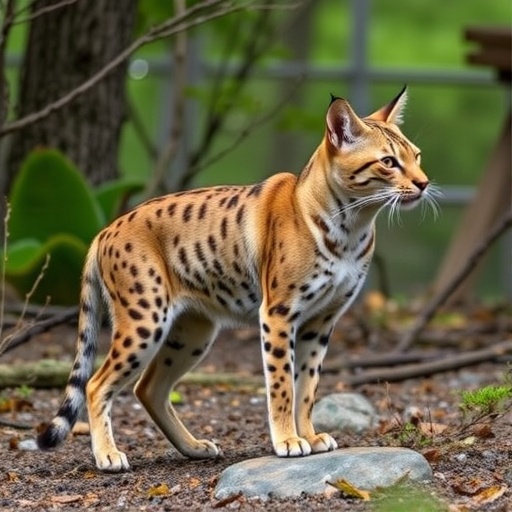In an unprecedented global study published in the prestigious Proceedings of the National Academy of Sciences, scientists have uncovered a striking difference in how two major carnivore families—canids and felids—navigate their territories. This breakthrough reveals that wild members of the dog family, including wolves, foxes, and coyotes, exhibit a distinct tendency to use well-established travel routeways within their habitats. In stark contrast, wild cats from bobcats to lions prefer a seemingly more fluid approach, wandering widely without a strong reliance on repeated pathways. This discovery fundamentally challenges long-standing assumptions about predator movement ecology.
The research, spearheaded by the University of Maryland’s William Fagan, utilized an extraordinary dataset comprising GPS tracking records from 1,239 individual carnivores spanning 34 species distributed over six continents. Drawing on a decade of high-resolution movement data, the study represents the most comprehensive comparative investigation of carnivore movement behavior ever conducted. Such a scale and scope enable robust insights into ecological patterns that were previously obscured by assumptions of randomness in animal spatial use.
A central revelation of the study is that canids construct dense, repeatable “routeways” or travel highways in their territories, which they consistently use. These pathways, often invisible to the human eye, likely serve critical ecological and evolutionary functions—from efficient foraging and territorial patrols to facilitating social communication through scent marking. In contrast, felids display far fewer of these routeways, instead adopting a wandering strategy that allows them to explore a broader area more randomly, potentially reflecting different hunting and territorial strategies.
One technical explanation for this dichotomy lies in sensory biology. Canids possess an exceptionally refined sense of smell, far superior to that of felids. This olfactory prowess likely aids them in establishing and remembering preferred routes by navigating through scent trails left by themselves and conspecifics. This sensory advantage may have co-evolved with the behavioral patterns of route reuse, embedding an evolutionary strategy that optimizes resource use and territorial control through repeated spatial movements.
By contrast, felids, equipped with keen vision and stealth adaptations, may prioritize unpredictability in movement to enhance hunting success and avoid detection—both by prey and rival predators. Their relatively weaker olfactory capabilities diminish the utility of fixed scent-guided corridors, resulting in less structured spatial patterns. The study suggests that these lineage-specific differences in movement are deeply entrenched, having evolved since the divergence of canids and felids over millions of years.
Traditionally, ecological models of predator space use assumed largely random movement within home ranges, a simplification that helped formulate population dynamics and predator-prey interaction theories. However, the clear evidence of canid routeway reuse demands a reevaluation of these traditional mathematical frameworks. Incorporating route fidelity and the underlying sensory mechanisms into models promises more accurate predictions of predator behavior and ecosystem impacts.
Importantly, the team’s rigorous analysis controlled for numerous environmental variables—such as vegetation types, terrain, and human disturbance—strengthening the conclusion that the observed differences are inherent to the families themselves rather than artifacts of habitat variation. When comparing canids and felids within identical landscapes, the contrast in movement strategies became even more pronounced, emphasizing the fundamental nature of these behavioral patterns.
The implications of these findings extend beyond theoretical ecology into practical conservation and management. Predictable travel corridors used by canids could, for instance, become focal points for mitigating human-wildlife conflicts, designing wildlife corridors, or targeting anti-poaching efforts. Understanding these movement networks also improves epidemiological modeling of disease transmission since repeated use of spatial pathways can facilitate or limit pathogen spread among individuals within populations.
Furthermore, this research enhances our grasp of how animals navigate complex environments and optimize their energy expenditures across large territories. Canids appear to benefit from the establishment and maintenance of efficient spatial routes to maximize the cost-effectiveness of territorial patrols and resource acquisition. Felids’ more variable spatial use strategies demonstrate alternative evolutionary solutions to survival challenges, underscoring the diversity of behavioral adaptation among apex predators.
The extensive collaborative effort underscoring these insights involved 177 researchers worldwide and exemplifies how cutting-edge GPS technology combined with sophisticated statistical analyses can unveil hidden layers of animal behavior previously inaccessible to science. The logistics of this massive data integration were formidable, beginning as remote exchanges during the global COVID pandemic and culminating in a breakthrough that redefines carnivore ecology.
Beyond the immediate findings, the study also opens intriguing avenues for further research into the cognitive mechanisms behind route memory and spatial navigation in wildlife. Unraveling how canids internalize and recall complex travel networks could illuminate the neurological basis of animal navigation, potentially informing biomimetic designs in robotics and artificial intelligence as well.
In summary, this landmark study revolutionizes our understanding of carnivore movement patterns by revealing that dog family members exhibit sophisticated spatial structuring through frequent reuse of travel routeways, while cat family members navigate more fluidly and less predictably. These divergent strategies reflect deep evolutionary legacies shaped by sensory capabilities and ecological pressures. The findings hold transformative potential for conservation biology, ecological modeling, and our broader comprehension of animal spatial behavior.
Subject of Research: Animals
Article Title: Wild canids and felids differ in their reliance on reused travel routeways
News Publication Date: Week of September 29, 2025
Web References: https://doi.org/10.1073/pnas.2401042122
References: Fagan, W.F., Calabrese, J.M., et al. (2025). Wild canids and felids differ in their reliance on reused travel routeways. Proceedings of the National Academy of Sciences, DOI: 10.1073/pnas.2401042122
Keywords: Migration tracking, Ecological methods, Ecoinformatics, Evolutionary ecology, Ecological speciation, Ecological adaptation, Natural populations, Wild populations, Population biology, Population dynamics, Population expansion, Population ecology
Tags: animal spatial use analysisbehavioral ecology of wild dogscanid movement behaviorscarnivore territory navigationcomparative study of felids and canidsecological patterns in predator movementfluid movement in wild catsGPS tracking of carnivoresimpact of habitat on predator routesscientific study of animal navigationterritory use in carnivoreswild cat navigation strategies





